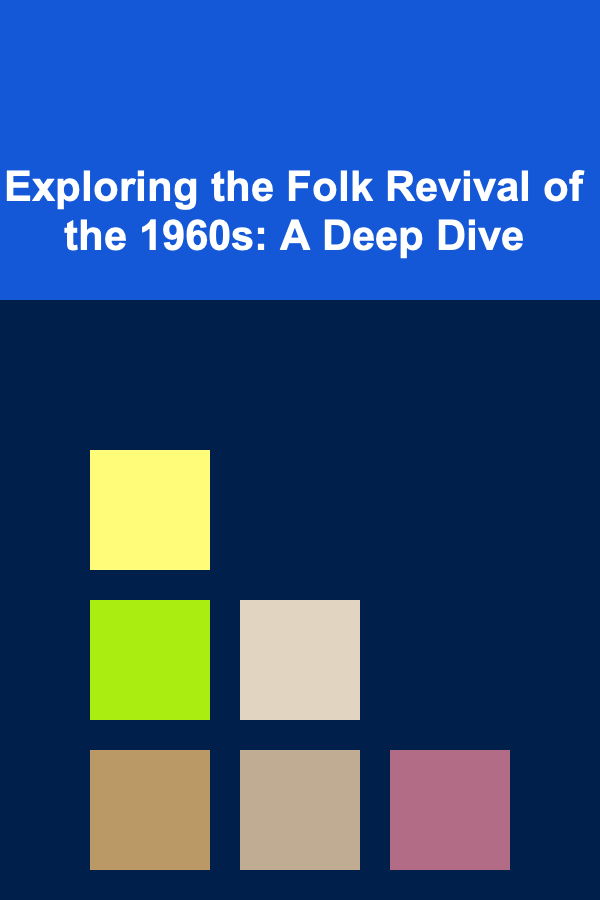
Exploring the Folk Revival of the 1960s: A Deep Dive
ebook include PDF & Audio bundle (Micro Guide)
$12.99$11.99
Limited Time Offer! Order within the next:

The 1960s folk revival was more than just a musical trend; it was a cultural phenomenon, a societal mirror reflecting the anxieties, hopes, and burgeoning activism of a generation. To truly explore this pivotal period in music history, one must delve into its historical context, its key figures, its diverse influences, and its lasting legacy. This essay aims to provide a comprehensive guide to understanding and appreciating the folk revival, offering pathways for further exploration and critical engagement.
Setting the Stage: Precursors to the Revival
The 1960s folk revival didn't emerge from a vacuum. It built upon existing traditions and movements, drawing inspiration from a rich tapestry of American musical heritage. Understanding these precursors is crucial for grasping the full scope of the revival.
- The First Folk Revival (1930s-1940s): The seeds of the 1960s revival were sown in the 1930s and 40s, fueled by the Great Depression and the rise of social consciousness. Artists like Woody Guthrie championed the plight of the working class, using folk songs as a vehicle for protest and social commentary. Guthrie's Dust Bowl ballads and union songs resonated deeply with a nation grappling with economic hardship. This earlier revival focused on preserving and popularizing authentic folk music, often collected and transcribed by ethnomusicologists like Alan Lomax, who meticulously documented traditional songs from diverse communities across America.
- The Weavers and the Red Scare: The Weavers, a popular folk group formed in the late 1940s, brought folk music to a wider audience. However, their left-leaning politics made them targets of the Red Scare, leading to blacklisting and a decline in their popularity. Despite this setback, The Weavers paved the way for future folk artists and demonstrated the power of folk music as a platform for social and political expression. Their success, followed by their suppression, highlighted the volatile relationship between folk music and political power.
- The Blues and Gospel Traditions: The blues and gospel music, originating from African American communities, were essential influences on the folk revival. Artists like Lead Belly and Sister Rosetta Tharpe, while not strictly "folk" in the traditional sense, brought raw emotion and powerful storytelling to their performances. Their music, often rooted in personal experience and social realities, influenced countless folk artists who sought to capture the authenticity and depth of these traditions. The civil rights movement, gaining momentum in the 1950s, further amplified the importance of these musical forms as expressions of resistance and hope.
Key Figures and Their Contributions
The 1960s folk revival was driven by a constellation of talented artists, each contributing their unique voice and perspective to the movement.
- Bob Dylan: Arguably the most influential figure of the folk revival, Bob Dylan transcended the boundaries of traditional folk music. He began as a protest singer, writing powerful anthems like "Blowin' in the Wind" and "The Times They Are a-Changin'," which became rallying cries for the civil rights and anti-war movements. Dylan's poetic lyrics, often imbued with social commentary and personal introspection, revolutionized songwriting and established him as a literary and musical icon. His later embrace of electric instruments in the mid-1960s sparked controversy among purists but broadened the scope of folk-rock and cemented his position as a musical innovator.
- Joan Baez: Known for her crystal-clear soprano voice and unwavering commitment to social justice, Joan Baez was a prominent voice of the folk revival. She popularized traditional folk songs and championed the cause of civil rights, performing alongside Martin Luther King Jr. and participating in numerous protests. Baez's interpretations of traditional ballads and her own original compositions helped to bring folk music to a wider audience and inspired countless young people to become involved in social activism. She was also instrumental in introducing Bob Dylan to a larger audience early in his career.
- Pete Seeger: A veteran of the first folk revival, Pete Seeger continued to be a leading figure in the 1960s. He was a passionate advocate for social justice and environmentalism, using his music to raise awareness about important issues. Seeger's singalongs and community performances fostered a sense of collective action and empowered ordinary people to use their voices for change. He was a master of the banjo and a tireless champion of folk music as a tool for social progress. Despite facing blacklisting during the Red Scare, Seeger continued to perform and inspire generations of musicians and activists.
- Judy Collins: With her soprano voice and interpretive skills, Judy Collins brought a touch of sophistication to the folk revival. She was known for her renditions of both traditional and contemporary folk songs, as well as her interpretations of works by songwriters like Leonard Cohen and Joni Mitchell. Collins's diverse repertoire and her ability to connect with audiences on an emotional level made her a popular and influential figure in the folk revival. She also played a significant role in introducing new songwriters to a wider audience.
- Phil Ochs: A more overtly political songwriter than many of his contemporaries, Phil Ochs wrote topical songs that addressed issues such as the Vietnam War, civil rights, and social injustice. His songs were often satirical and darkly humorous, reflecting his disillusionment with the political establishment. Ochs's passionate performances and his willingness to speak truth to power made him a hero to many in the anti-war movement. Tragically, he struggled with mental health issues and died by suicide in 1976.
- The Kingston Trio: The Kingston Trio, with their clean-cut image and polished harmonies, helped to popularize folk music among mainstream audiences. Their commercial success paved the way for other folk artists and helped to create a wider market for folk music. While some critics dismissed them as being too commercial, The Kingston Trio played a crucial role in bringing folk music into the American consciousness.
Venues and Communities: The Hubs of the Revival
The folk revival flourished in specific venues and communities, providing spaces for artists to perform, audiences to connect, and ideas to be exchanged.
- Greenwich Village, New York City: Greenwich Village was the epicenter of the folk revival. Coffeehouses like Gerde's Folk City and The Gaslight Cafe provided intimate settings for artists to perform and develop their craft. The Village attracted musicians, writers, artists, and activists, creating a vibrant and intellectually stimulating environment. This melting pot of creativity fostered innovation and experimentation, shaping the sound and spirit of the folk revival. The Village also served as a hub for political organizing and social activism.
- Coffeehouses and Folk Clubs: Beyond Greenwich Village, coffeehouses and folk clubs sprang up in cities and college towns across the country, providing venues for local and national folk artists to perform. These venues fostered a sense of community and provided a platform for emerging artists to gain exposure. They were also important spaces for political discussion and social organizing. These venues often served as incubators for local talent, fostering a sense of community and artistic collaboration.
- Folk Festivals: Folk festivals, such as the Newport Folk Festival, played a crucial role in showcasing established and emerging artists and bringing folk music to a wider audience. These festivals brought together musicians, fans, and industry professionals, creating a sense of community and celebrating the diversity of folk music. The Newport Folk Festival, in particular, became a significant platform for political expression, with artists using their performances to address issues such as civil rights and the Vietnam War. Bob Dylan's controversial performance with electric instruments at the 1965 Newport Folk Festival marked a turning point in the folk revival.
- College Campuses: College campuses were important centers for the folk revival, with students organizing concerts, coffeehouses, and political activities. The folk revival resonated deeply with young people who were questioning social norms and seeking meaningful ways to express their concerns. College campuses provided a receptive audience for folk music and a fertile ground for social activism. Student organizations often organized concerts and events featuring folk artists, raising awareness about social and political issues.
Thematic Concerns: What the Songs Were About
The folk songs of the 1960s revival were not simply entertainment; they were powerful statements about the issues that mattered most to the generation. Exploring these thematic concerns provides insight into the cultural and political landscape of the era.
- Civil Rights: The civil rights movement was a central theme of the folk revival. Songs like "We Shall Overcome" and "Blowin' in the Wind" became anthems of the movement, expressing the hopes and aspirations of African Americans fighting for equality. Folk artists used their music to raise awareness about racial injustice and to inspire action. They also performed at civil rights rallies and protests, lending their voices to the cause.
- The Vietnam War: The Vietnam War was another major theme of the folk revival. Songs like "Where Have All the Flowers Gone?" and "Masters of War" expressed the growing anti-war sentiment and questioned the morality of the conflict. Folk artists used their music to protest the war and to advocate for peace. The war divided the nation and fueled social unrest, and folk music provided a powerful outlet for expressing dissent.
- Social Justice: Folk songs addressed a wide range of social justice issues, including poverty, inequality, and environmental degradation. Artists used their music to raise awareness about these issues and to advocate for social change. They often drew inspiration from the experiences of marginalized communities and used their songs to amplify their voices. The folk revival was deeply intertwined with the broader social justice movements of the 1960s.
- Love and Relationships: While often overshadowed by political themes, folk songs also explored personal themes such as love, loss, and relationships. These songs often reflected the changing social norms and the evolving roles of men and women. They provided a glimpse into the personal lives and emotions of a generation grappling with identity and self-discovery.
- The Environment: The nascent environmental movement also found expression in folk music. Artists like Pete Seeger raised awareness about pollution and the need to protect the natural world. Their songs helped to inspire a growing awareness of environmental issues and to promote conservation efforts. This was a relatively new theme in popular music at the time, reflecting a growing concern about the impact of human activity on the planet.
The Influence of Traditional Music
While many artists wrote original songs, the folk revival also involved a rediscovery and reinterpretation of traditional folk music from various cultures.
- Appalachian Folk Music: Appalachian folk music, with its distinctive vocal harmonies and instrumental styles, was a major influence on the folk revival. Artists like the New Lost City Ramblers and Doc Watson helped to preserve and popularize this rich musical tradition. Appalachian music provided a link to the past and a sense of cultural heritage. Its themes of hardship, resilience, and community resonated with audiences during a time of rapid social change.
- British Isles Folk Music: Folk songs from England, Scotland, and Ireland were also popular during the revival. Artists like Joan Baez and Judy Collins drew inspiration from these traditions, incorporating them into their repertoire. British Isles folk music offered a diverse range of melodies, rhythms, and lyrical themes. Its historical depth and its connection to oral traditions appealed to audiences seeking authenticity and cultural roots.
- World Music Influences: As the folk revival progressed, artists began to incorporate influences from other cultures around the world. This broadening of musical horizons reflected a growing awareness of global issues and a desire to create a more inclusive and diverse musical landscape. The incorporation of world music elements added new textures and perspectives to the folk revival.
The Transition to Folk Rock and the Decline of the Revival
The folk revival eventually transitioned into folk rock, a genre that blended folk music with electric instruments and rock and roll rhythms. This transition marked a shift in the sound and style of folk music, and it ultimately contributed to the decline of the revival.
- Bob Dylan's Electric Turn: Bob Dylan's decision to embrace electric instruments in the mid-1960s was a pivotal moment in the history of folk music. While some purists criticized him for abandoning the acoustic tradition, others embraced his experimentation and saw it as a natural evolution of the genre. Dylan's electric performances sparked controversy and debate within the folk community, but they also helped to pave the way for folk rock.
- The Rise of Folk Rock Bands: Following Dylan's lead, other folk artists began to experiment with electric instruments, leading to the emergence of folk rock bands such as The Byrds, The Lovin' Spoonful, and Simon & Garfunkel. These bands combined folk melodies and lyrical themes with rock and roll instrumentation and rhythms, creating a new and exciting sound. Folk rock brought folk music to a wider audience and helped to revitalize the genre.
- The Changing Social and Political Landscape: As the 1960s progressed, the social and political landscape began to change. The civil rights movement made significant gains, but the Vietnam War continued to escalate, leading to increased social unrest. The rise of counterculture and the emergence of new musical genres such as psychedelic rock also contributed to the decline of the folk revival. The focus shifted from folk's often explicit protest to more nuanced and psychedelic forms of social commentary.
- Fragmentation and Commercialization: The folk revival eventually became fragmented as artists explored different directions and as the genre became increasingly commercialized. The original spirit of authenticity and social commitment that had fueled the revival began to fade. The influx of commercial interests and the pressure to conform to mainstream tastes diluted the original message of the folk revival.
The Lasting Legacy of the Folk Revival
Despite its decline, the 1960s folk revival left a lasting legacy on American music and culture. Its influence can still be heard in contemporary music, and its themes of social justice and political activism continue to resonate with audiences today.
- Influence on Songwriting: The folk revival revolutionized songwriting, emphasizing lyrical content and social commentary. Artists like Bob Dylan demonstrated the power of song lyrics to address important issues and to inspire change. His poetic and politically charged lyrics influenced generations of songwriters. The emphasis on storytelling and lyrical depth in folk music continues to influence songwriting today.
- Social and Political Activism: The folk revival helped to inspire a generation of social and political activists. Folk songs became anthems of the civil rights movement and the anti-war movement, and folk artists used their music to raise awareness about important issues. The connection between music and social activism remains strong today. The folk revival demonstrated the power of music to mobilize people and to effect social change.
- Preservation of Traditional Music: The folk revival helped to preserve and popularize traditional folk music from various cultures. Artists like Pete Seeger and Joan Baez championed the importance of preserving cultural heritage and passing it on to future generations. The revival fostered a renewed appreciation for traditional music forms and inspired efforts to document and preserve them.
- The Singer-Songwriter Movement: The folk revival paved the way for the singer-songwriter movement of the 1970s, which saw artists like Joni Mitchell, James Taylor, and Carole King achieve mainstream success with their introspective and personal songs. The emphasis on authentic expression and personal storytelling in the folk revival laid the foundation for the singer-songwriter movement. These artists continued to explore themes of love, loss, and identity in their music.
- Continuing Relevance Today: The themes of social justice, political activism, and environmentalism that were central to the folk revival remain relevant today. Contemporary artists continue to draw inspiration from the folk revival, using their music to address important issues and to inspire change. The folk revival serves as a reminder of the power of music to connect people, to inspire hope, and to create a more just and equitable world. The struggles and triumphs of the 1960s continue to resonate with contemporary audiences.
Further Exploration: Resources and Methods
To delve deeper into the 1960s folk revival, consider these resources and methods:
- Listen to the Music: Start by listening to the music of the key artists mentioned above. Explore their albums, live performances, and archival recordings. Pay attention to the lyrics, melodies, and instrumentation, and consider the historical context in which the music was created. Streaming services like Spotify and Apple Music offer access to vast catalogs of folk music.
- Read Biographies and Histories: Read biographies of key figures like Bob Dylan, Joan Baez, and Pete Seeger. Explore histories of the folk revival, such as "Positively Fourth Street" by David Hajdu and "Baby Let Me Follow You Down" by Eric von Schmidt and Jim Rooney. These books provide valuable insights into the lives of the artists and the social and political context of the era.
- Watch Documentaries and Films: Watch documentaries and films about the folk revival, such as "No Direction Home: Bob Dylan" and "Joan Baez: How Sweet the Sound." These films offer visual and audio documentation of the era and provide perspectives from the artists themselves.
- Explore Archival Resources: Explore archival resources such as the Alan Lomax Archive and the Smithsonian Folkways Recordings. These archives contain vast collections of traditional folk music and related materials. These resources offer a wealth of information for researchers and enthusiasts alike.
- Visit Museums and Historical Sites: Visit museums and historical sites related to the folk revival, such as the Woody Guthrie Center in Tulsa, Oklahoma, and the Newport Folk Festival Museum in Newport, Rhode Island. These sites offer opportunities to learn more about the history of the folk revival and to connect with its legacy.
- Attend Folk Festivals and Concerts: Attend contemporary folk festivals and concerts to experience the ongoing legacy of the folk revival. Many contemporary artists continue to perform traditional folk songs and to write new songs in the folk tradition. Attending these events provides an opportunity to connect with the music and the community that sustains it.
- Engage in Critical Analysis: Engage in critical analysis of the music and the movement. Consider the social, political, and cultural context in which the folk revival occurred. Analyze the lyrics of the songs and consider their meaning and significance. Examine the role of the folk revival in shaping American identity and culture.
By engaging with these resources and methods, you can gain a deeper understanding and appreciation of the 1960s folk revival, a pivotal moment in American music history that continues to inspire and resonate today. Exploring the folk revival is not just about understanding the music; it's about understanding the social, political, and cultural forces that shaped a generation.

Eco-Friendly and Affordable Alternative Transportation Options You Need to Know
Read More
How to Use Etsy Shop Management to Make Money
Read More
How to Use Smart Home Features to Enhance Your Staging
Read More
Identifying Logical Fallacies in Conspiracy Arguments
Read More
Debunking the Bermuda Triangle Mystery: Separating Fact from Fiction
Read MoreHow to Build a DIY Vision Insurance Expense Tracker
Read MoreOther Products

Eco-Friendly and Affordable Alternative Transportation Options You Need to Know
Read More
How to Use Etsy Shop Management to Make Money
Read More
How to Use Smart Home Features to Enhance Your Staging
Read More
Identifying Logical Fallacies in Conspiracy Arguments
Read More